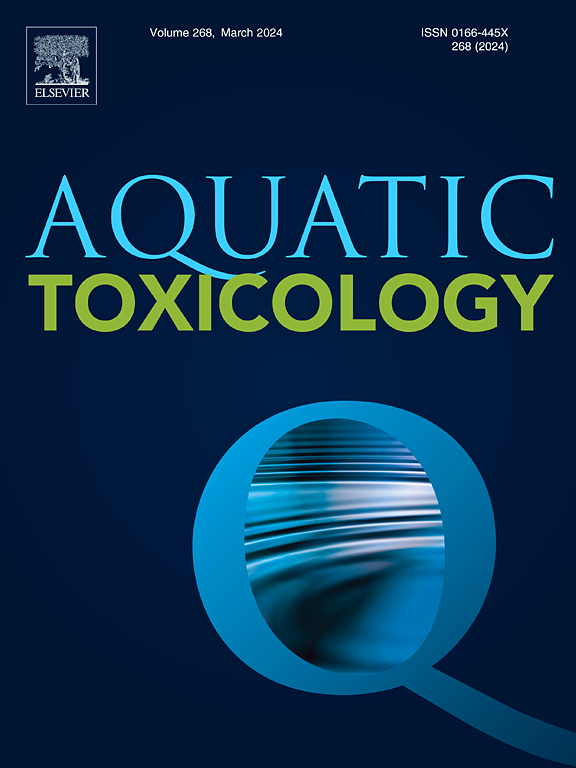镉和二氧化钛纳米颗粒对中华水藻蝌蚪的单一和联合慢性毒性研究
IF 4.1
2区 环境科学与生态学
Q1 MARINE & FRESHWATER BIOLOGY
引用次数: 0
摘要
二氧化钛纳米颗粒(TiO2 NPs)在水生系统中的生产和处置不当带来了相当大的环境挑战,特别是当这些颗粒与镉(Cd)等其他污染物相互作用时。因此,本研究的目的是评估潜在的毒性作用对鳃、软骨头盖骨、身体生长和死亡的Aquarana catesbeiana蝌蚪。将蝌蚪单独或联合暴露于与环境相关浓度的TiO2 NPs(10µg L-1)和CdCl2(10µg L-1)中30天(慢性暴露),并与对照组一起。我们的研究结果表明,TiO2 NPs和Cd共暴露可导致较高的死亡率。在鳃中,TiO2 NPs导致上皮简化,而Cd暴露导致分层上皮形成。此外,共暴露组的退行性改变指数以及Cd和混合物暴露组的整体器官指数均有显著变化。结果表明,该混合物在骨骼系统发育过程中具有潜在的毒理学作用。形态计量学分析还显示,共同暴露组的蝌蚪体长缩短,身体比例异常。综上所述,TiO2 NPs和Cd单独或联合对中华绒螯虾蝌蚪具有毒性作用,表明将这些污染物释放到水生环境中可能存在潜在的生态风险。本文章由计算机程序翻译,如有差异,请以英文原文为准。

Single and combined chronic toxicity of cadmium and titanium dioxide nanoparticles in Aquarana catesbeiana (Anura: Ranidae) tadpoles
The rising production and improper disposal of titanium dioxide nanoparticles (TiO2 NPs) into aquatic systems present considerable environmental challenges, especially when these particles interact with other contaminants such as cadmium (Cd). Thus, the current study aimed to evaluate the potential toxic effects on the gills, chondrocranium, body growth, and mortality of Aquarana catesbeiana tadpoles. The tadpoles were exposed to environmentally relevant concentrations of TiO2 NPs (10 µg L-1), and CdCl2 (10 µg L-1), both individually and in combination, for 30 days (chronic exposure), along with a control group. Our results indicate that the co-exposure to TiO2 NPs and Cd induced a higher mortality rate. In the gills, TiO2 NPs led to epithelial simplification, while Cd exposure resulted in stratified epithelium formation. Additionally, there were notable changes in the index of degenerative alterations for the co-exposed group and the overall organ index for the groups exposed to Cd and the mixture. The viscerocranium showed significant malformations in the ceratobranchials and reticular processes, indicating the mixture's toxicological potential during the skeletal system's development. Morphometric analysis also revealed reduced body length and abnormal body ratios in tadpoles from the co-exposure group. In conclusion, TiO2 NPs and Cd, both alone and in combination, exhibit toxicological effects in A. catesbeiana tadpoles, indicating a potential ecological risk associated with releasing these contaminants into aquatic environments.
求助全文
通过发布文献求助,成功后即可免费获取论文全文。
去求助
来源期刊

Aquatic Toxicology
环境科学-毒理学
CiteScore
7.10
自引率
4.40%
发文量
250
审稿时长
56 days
期刊介绍:
Aquatic Toxicology publishes significant contributions that increase the understanding of the impact of harmful substances (including natural and synthetic chemicals) on aquatic organisms and ecosystems.
Aquatic Toxicology considers both laboratory and field studies with a focus on marine/ freshwater environments. We strive to attract high quality original scientific papers, critical reviews and expert opinion papers in the following areas: Effects of harmful substances on molecular, cellular, sub-organismal, organismal, population, community, and ecosystem level; Toxic Mechanisms; Genetic disturbances, transgenerational effects, behavioral and adaptive responses; Impacts of harmful substances on structure, function of and services provided by aquatic ecosystems; Mixture toxicity assessment; Statistical approaches to predict exposure to and hazards of contaminants
The journal also considers manuscripts in other areas, such as the development of innovative concepts, approaches, and methodologies, which promote the wider application of toxicological datasets to the protection of aquatic environments and inform ecological risk assessments and decision making by relevant authorities.
 求助内容:
求助内容: 应助结果提醒方式:
应助结果提醒方式:


